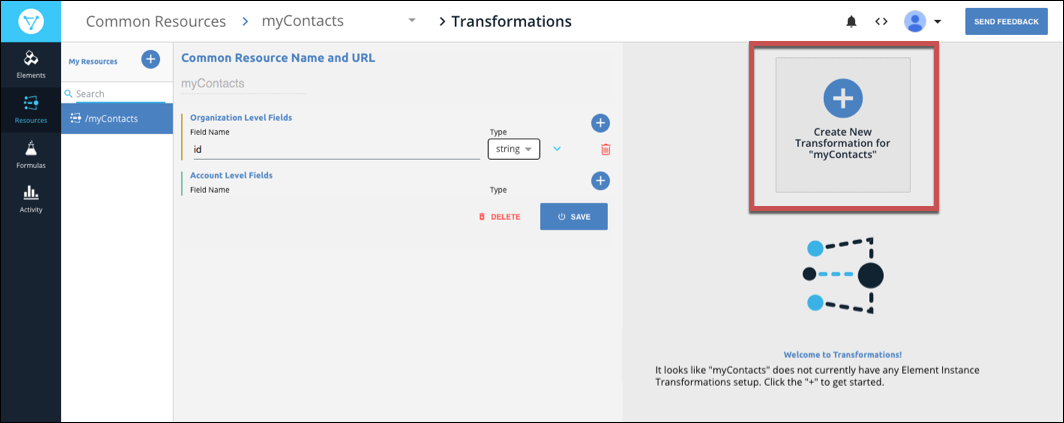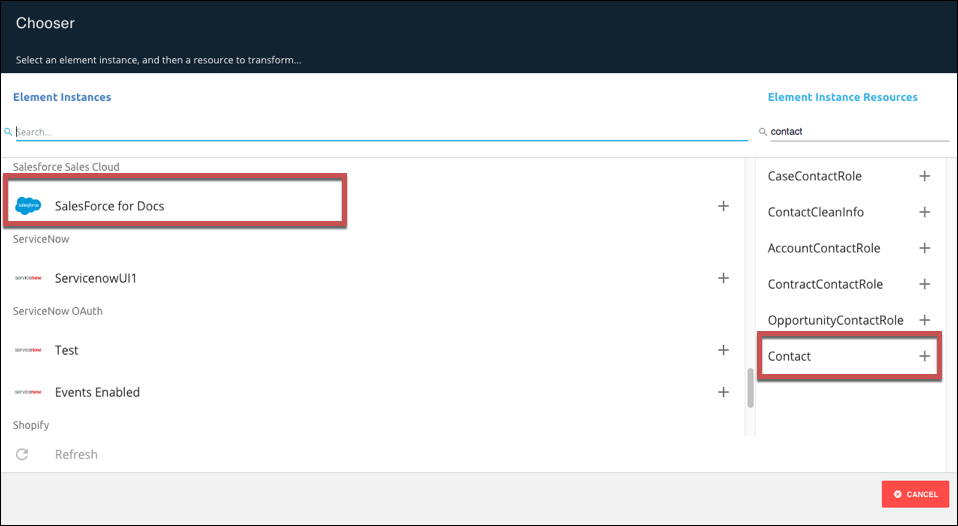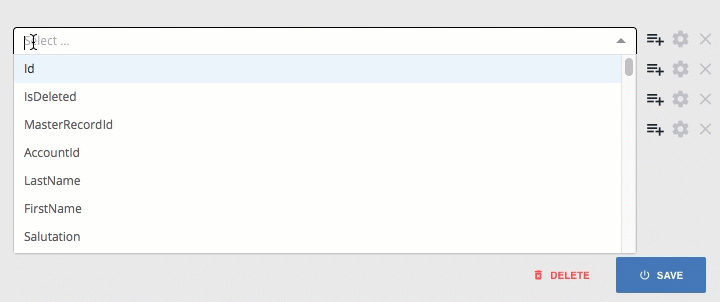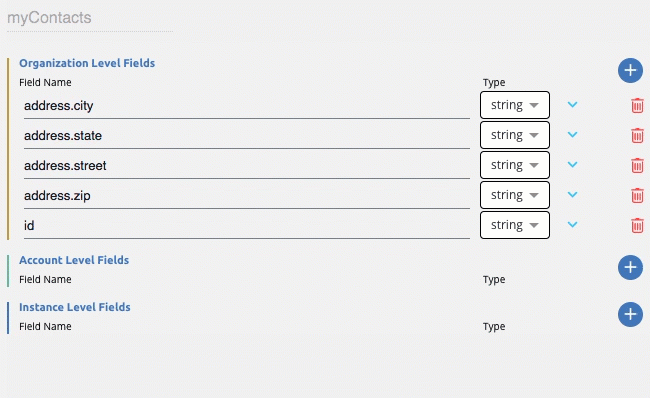The docs are moving!
Find us at our new Help Center where we've combined our documentation and knowledgebase articles in one easy-to-search location.
We aren't updating the Developer Portal anymore, except for the Element Docs — all updates happen in the Help Center. We're retiring the Developer Portal as you know it in:
Transforming Fields
A transformation is the result of the process of mapping fields in your element instance resources to existing fields and objects in a common resource. After you create a common resource, you will select an element instance, choose the resource containing the objects that you want to map to the common resource, and map fields to the common resource. The end result is a a transformation of the selected objects in the element instance.
Map Fields to the Common Resource
Use Javascript to Manage Complex Objects
Transforming Custom ObjectsRemoving Fields During TransformationSetting Default Values Testing Your Transformations Adding Your Common Resource to the API Docs Working with Nested Objects Access Levels and Transformations
Map Fields to the Common Resource
Before you can transform fields, you need to map the fields for each element instance to the common resource. The common resource fields are on the left and the element instance resource fields are on the right.
id field, which you can choose to map to an id field in the element's resource, delete, or rename to an entirely different field. If you created your common resource based on an existing resource, you will see more fields than just the id field. You can map fields one at a time, or you can add several fields to the common resource at once, and then map them later. These instructions describe mapping a single field at a time.
This section describes mapping to a common resource at the organization level. You must be an organization level user to map to organization level fields. For more about mapping at different levels, see Access Levels and Transformations.
To map fields:
On the Common Resources > Transformations page, click Create New Transformation.

Select the Element Instance, and then select the Element Instance Resource.
The Resources available to that Element Instance appear in the Element Instance Resources column after you select a resource.
 Tip: Use the search fields to find what you are looking for in long lists.
Tip: Use the search fields to find what you are looking for in long lists.Beginning with the default field id, select a field on the right to map to id.

Click
 next to the Organization Level Fields to add another field.Note: You can add fields at the account and instance level also, but these steps focus on creating an organization level common resource. For more information, see Access Levels and Transformations
next to the Organization Level Fields to add another field.Note: You can add fields at the account and instance level also, but these steps focus on creating an organization level common resource. For more information, see Access Levels and TransformationsEnter a name for the field, and then choose the data type if the field is something other than a string.
Select the corresponding field on the right to map to the new field.
Note: You can type to filter.
Continue adding resources until you finish, and then click Save.
To map another instance, click Transformations in the breadcrumbs at the top of the page.

Tips
- You don't have to map fields one at a time. You can add multiple fields to the Common Resources side at once, and then map them later. Use
 to show only those element instance resource fields that haven't been mapped.
to show only those element instance resource fields that haven't been mapped. - If you made a mistake and don't want to include a field in a common resource, click
 . If you still want the field, but want to remove the mapping, click
. If you still want the field, but want to remove the mapping, click  .
. - If you need to map a custom field, click
 , and then type a name. See Advanced Common Resources: Transforming Custom Objects for details.
, and then type a name. See Advanced Common Resources: Transforming Custom Objects for details. - We use dot notation to show sub-objects in the element instance resources. If you need to create sub-objects in your common resource, use dot notation. Examples include address.city, address.state, and address.street. See Working With Nested Objects for details.
Use Javascript to Manage Complex Objects
You can use custom Javascript when the basic object mapping does not meet your needs. For example, you might need to break a single address object into its component parts (address.city, address.state, address.street, and address.zip).
- For all scripts, Javascript `strict` mode is enforced.
- ES6 is supported.
- The function parameters are immutable, meaning they cannot be assigned to directly. To change an object or value passed into the function, first copy it to your own local variable, and then make the necessary changes.
To access the custom Javascript functionality:
- Click
 .
.
Common resource functions include the parameters and functions in the following table:
Common Resources Custom JS Parameters and Functions
| Parameter | Description |
|---|---|
| transformedObject | The transformed object, with any mappings already taking place. |
| originalObject | The original object, with no transformations or mappings taking place on it. |
| fromVendor | Is the transformation being executed coming back from the vendor (on an API response) ? |
| done | The callback function needed to call at the end of your JS. Call done to terminate a given step. |
Libraries
- CE: Our custom library that provides some common functionality. It is not necessary to
requirethis library, it is available by default.CE.randomString(): Generate a random string (approx. 10 characters long).CE.randomEmail(): Generate a random email address.CE.md5(str): Create an MD5 hash from a string value. Takes astringas a parameter. Returns astring.CE.b64(str): Encode a string in base64. Takes astringas a parameter. Returns astring.CE.decode64(str): Decode a string from base64, using UTF-8 encoding. Takes astringas a parameter. Returns astring.CE.hmac(algo)(enc)(secret, str): HMAC hash a string (str) using the provided secret (secret), algorithm (algo), and encoding (enc). See https://nodejs.org/api/crypto.html#crypto_class_hmac for more information about the algorithm and encoding parameters.CE.hmac[algo][enc](secret, str): This is a set of convenience functions that allow HMAC hashing using some common algorithms and encodings. For example,CE.hmacSha1Hex(secret, str)will create an HMAC SHA1 hash of the provided string, using the provided secret, and return a hex string. You can replace algo and enc with the following values: algo:Sha1,Sha256,Md5enc:Hex,base64
- Lodash: The popular
lodashlibrary. To use this library, simplyrequireit in your script. It is possible to use the library modules, as well, such aslodash/fp. - Util: The standard Node
utillibrary. To use,requireit in your script.
Examples
Adding fields to a resource when a certain endpoint does not provide them:
function (originalObject, transformedObject, fromVendor, done) { transformedObject.isCreatedThisYear = (fromVendor && transformedObject.createdDt > '2016-01-01'); done(transformedObject); }Two endpoints identify priority differently: one users numbers (1 or 2) and the other descriptions (low or high).
function (originalObject, transformedObject, fromVendor, done) { if (!fromVendor) done(transformedObject); // only care when returning data from the vendor transformedObject.priority = transformedObject.priorityNumber === 1 ? 'low' : 'high'; // we prefer our priority to be the string representation, so we convert the endpoints "priorityNumber" field to the appropriate string representation here. done(transformedObject); }Combining FirstName and LastName fields.
function (originalObject, transformedObject, fromVendor, done) { if transformedObject.Name = originalObject.FirstName + ' ' + originalObject.LastName; done(transformedObject); }
Transforming Custom Objects
If you do not see an object that you expect in the instance resources, you can still map it by entering the object name. This sometime happens for custom objects you created at the endpoint.
To map a custom object:
Click
 .
.The list becomes a text entry field.
Enter the name of the object.

Removing Fields During Transformation
Cloud Elements passes through all fields in the JSON on both requests and responses. However, you can choose to remove all unmapped fields or specific fields from requests or responses.
To remove unmapped fields:
- On the Transformations page, click
 .
. - Switch Remove Unmapped Fields to on.
- Click Save.
To remove fields from requests or responses:
- On the Transformations page, click
 .
. Switch on or off the sliders for the requests or responses.
For example, in the following configuration, we remove the portal-id field from the response.

Transforming Data Types
You can transform the data types on vendor objects. In most cases, you only need to select a new data type, but for dates you also provide a mask, or date format.
To change data types:
- On the Transformations page, click
 .
. - Select a type from the list.
- If you select date, add a date format to the Date Mask.

Setting Default Values
If no values exist for a specific field, but you do not want to remove it, you can set a default value.
To set a default value:
- On the Transformations page, click
 .
. - Click Default Value, and then type the value.
- Click Save.
Testing Your Transformations
After you set up your mapping, you can test your transformations.
To test a transformation:
- On the Transformations page, click
 .
. - Review the transformed response body. This is the response containing only the fields in your common resource.
- Click Original to see the entire response JSON payload.
Test a Put or Patch by selecting the appropriate method, and then entering the JSON request.
Tip: Copy the JSON payload from Transformed.Click Run.
Adding Your Common Resource to the API Docs
You can add the common resource you create to the instances of each affected element.
To add a common resource to API docs:
- On the Transformations page, click
 .
. - Switch Add to API Docs on.
- Click Save.
Try it out:
- Go to an element instance.
- Hover over the instance card, and the click API Docs.
- Scroll to your common resource.
Working with Nested Objects
We display sub-objects in dot notation. You can also use dot notation to nest objects in your common resource. For example, you might want to create nested address fields like those shown in the example below:

The JSON result of this nested object:
{
"Address": {
"city": "Cambridge",
"state": "MA",
"street":"1234567 Elm St",
"zip":"99999"
}
}
Access Levels and Transformations
You can map fields at different levels depending on your access. Organization level users can map at any level, while other users can map only at the instance level.
To map fields at the account level (organization level users only):
- Click
 by the level of fields that you want to map.
by the level of fields that you want to map.
To move mapping between levels:
Click the arrow next to the fields to move the fields between levels.
